MGT302: International Business Strategy Case Studies Analysis 2019
VerifiedAdded on 2023/04/04
|9
|1866
|257
Case Study
AI Summary
This assignment presents a case study analysis of international business strategies, focusing on two distinct scenarios: Subaru's export strategy and Myanmar's economic reforms. The analysis of Subaru examines the rationale behind their decision to export production from Japan, the benefits and currency risks associated with this strategy, the surge in sales and profits in 2014-2015, and the wisdom of expanding US production capacity. The Myanmar case study explores the reasons for the country's economic stagnation until recently, the key drivers for political and economic reforms from 2010 onwards, the nature of the economic reforms implemented, potential impediments to further improvements, and the potential impact and risks associated with the democratic victory in the general election. The document concludes with references to support the analysis. Desklib provides a platform for students to access similar solved assignments and past papers.
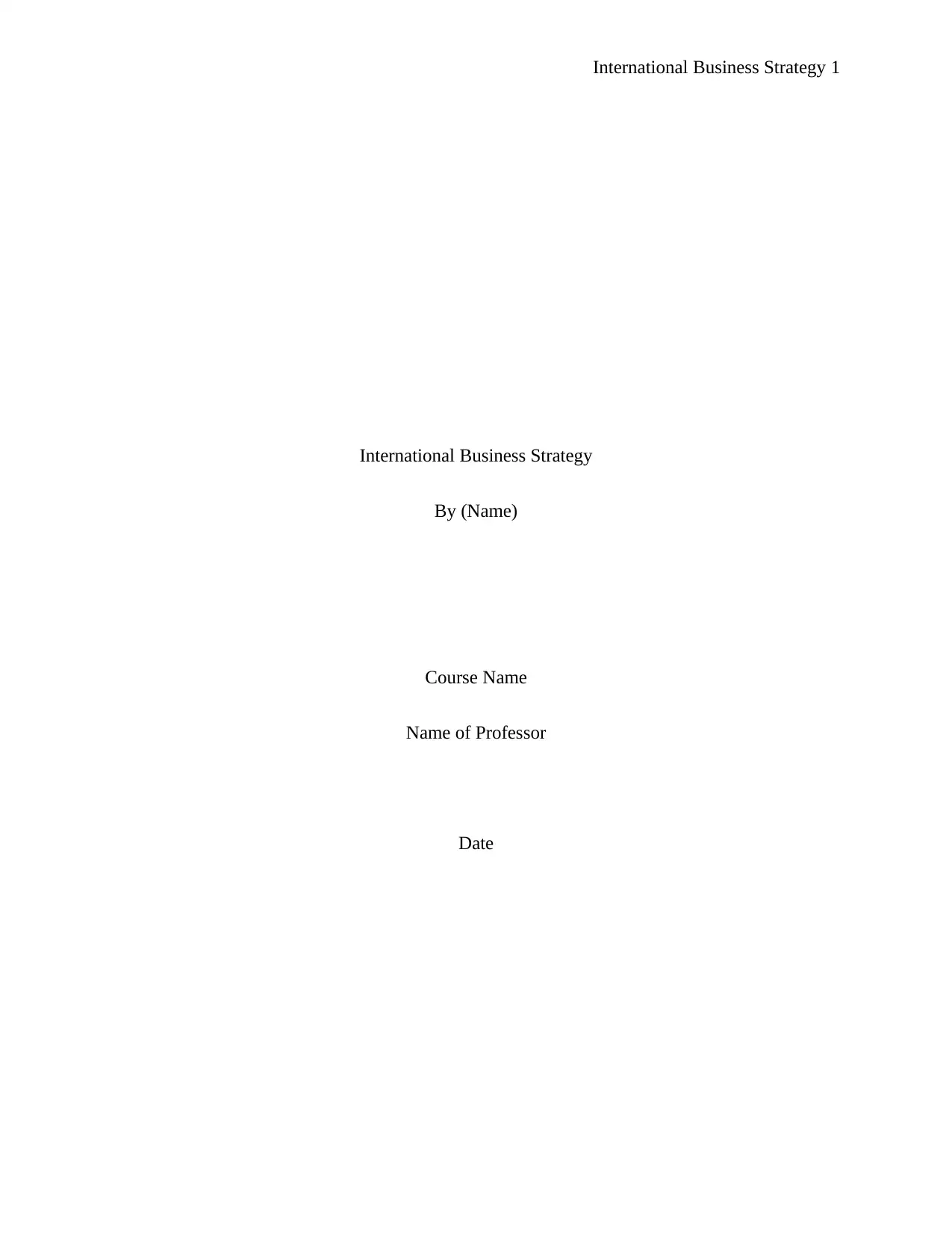
International Business Strategy 1
International Business Strategy
By (Name)
Course Name
Name of Professor
Date
International Business Strategy
By (Name)
Course Name
Name of Professor
Date
Paraphrase This Document
Need a fresh take? Get an instant paraphrase of this document with our AI Paraphraser
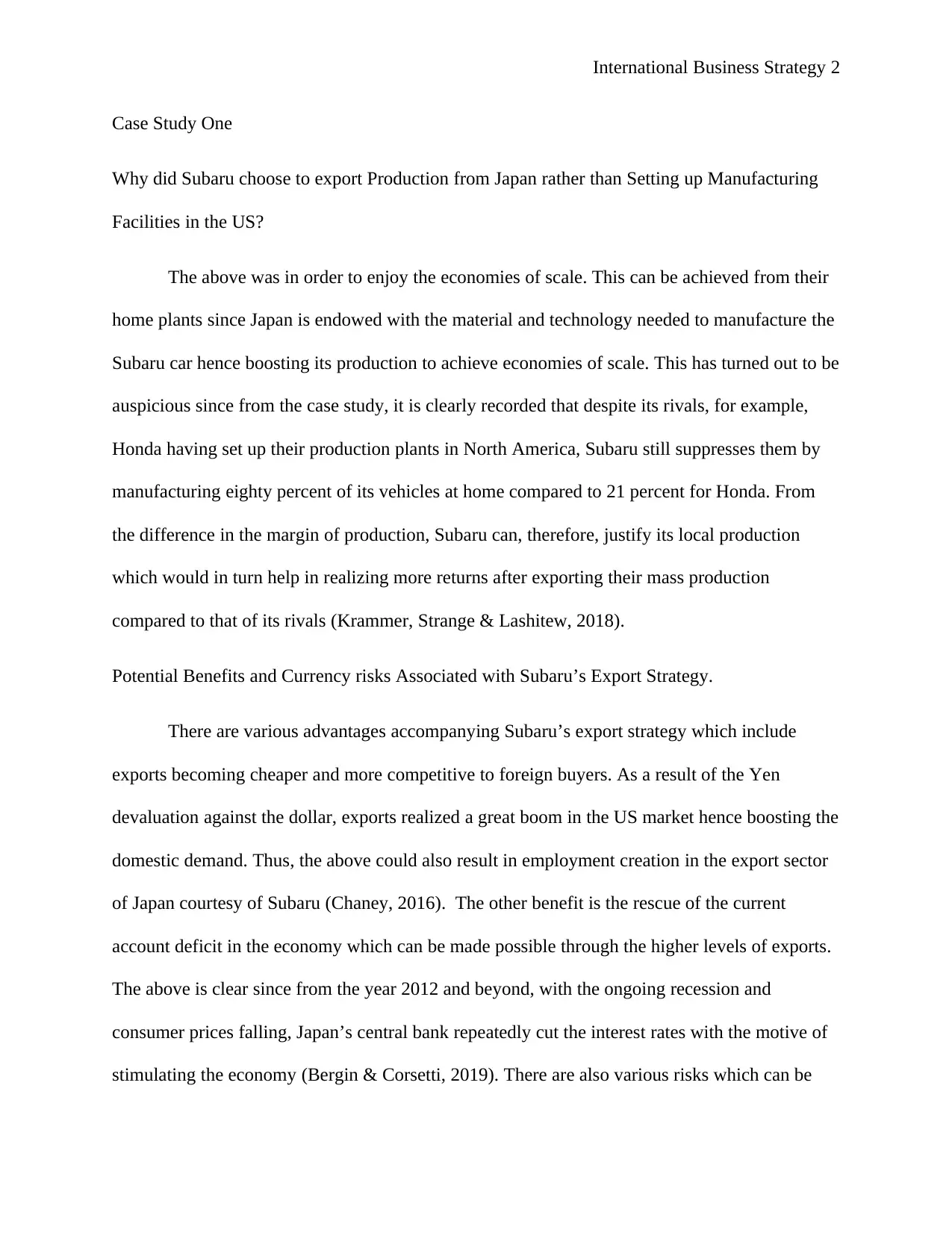
International Business Strategy 2
Case Study One
Why did Subaru choose to export Production from Japan rather than Setting up Manufacturing
Facilities in the US?
The above was in order to enjoy the economies of scale. This can be achieved from their
home plants since Japan is endowed with the material and technology needed to manufacture the
Subaru car hence boosting its production to achieve economies of scale. This has turned out to be
auspicious since from the case study, it is clearly recorded that despite its rivals, for example,
Honda having set up their production plants in North America, Subaru still suppresses them by
manufacturing eighty percent of its vehicles at home compared to 21 percent for Honda. From
the difference in the margin of production, Subaru can, therefore, justify its local production
which would in turn help in realizing more returns after exporting their mass production
compared to that of its rivals (Krammer, Strange & Lashitew, 2018).
Potential Benefits and Currency risks Associated with Subaru’s Export Strategy.
There are various advantages accompanying Subaru’s export strategy which include
exports becoming cheaper and more competitive to foreign buyers. As a result of the Yen
devaluation against the dollar, exports realized a great boom in the US market hence boosting the
domestic demand. Thus, the above could also result in employment creation in the export sector
of Japan courtesy of Subaru (Chaney, 2016). The other benefit is the rescue of the current
account deficit in the economy which can be made possible through the higher levels of exports.
The above is clear since from the year 2012 and beyond, with the ongoing recession and
consumer prices falling, Japan’s central bank repeatedly cut the interest rates with the motive of
stimulating the economy (Bergin & Corsetti, 2019). There are also various risks which can be
Case Study One
Why did Subaru choose to export Production from Japan rather than Setting up Manufacturing
Facilities in the US?
The above was in order to enjoy the economies of scale. This can be achieved from their
home plants since Japan is endowed with the material and technology needed to manufacture the
Subaru car hence boosting its production to achieve economies of scale. This has turned out to be
auspicious since from the case study, it is clearly recorded that despite its rivals, for example,
Honda having set up their production plants in North America, Subaru still suppresses them by
manufacturing eighty percent of its vehicles at home compared to 21 percent for Honda. From
the difference in the margin of production, Subaru can, therefore, justify its local production
which would in turn help in realizing more returns after exporting their mass production
compared to that of its rivals (Krammer, Strange & Lashitew, 2018).
Potential Benefits and Currency risks Associated with Subaru’s Export Strategy.
There are various advantages accompanying Subaru’s export strategy which include
exports becoming cheaper and more competitive to foreign buyers. As a result of the Yen
devaluation against the dollar, exports realized a great boom in the US market hence boosting the
domestic demand. Thus, the above could also result in employment creation in the export sector
of Japan courtesy of Subaru (Chaney, 2016). The other benefit is the rescue of the current
account deficit in the economy which can be made possible through the higher levels of exports.
The above is clear since from the year 2012 and beyond, with the ongoing recession and
consumer prices falling, Japan’s central bank repeatedly cut the interest rates with the motive of
stimulating the economy (Bergin & Corsetti, 2019). There are also various risks which can be
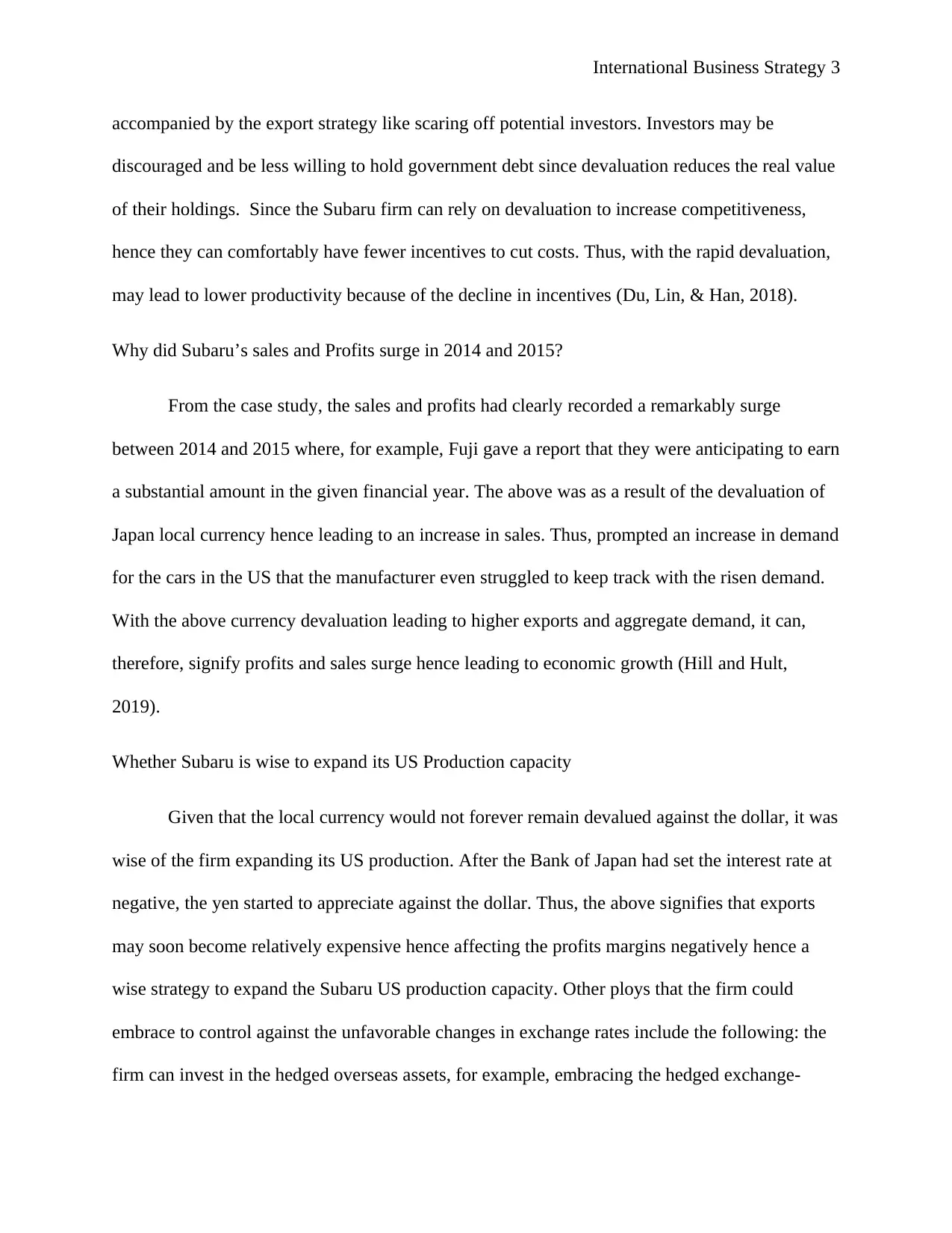
International Business Strategy 3
accompanied by the export strategy like scaring off potential investors. Investors may be
discouraged and be less willing to hold government debt since devaluation reduces the real value
of their holdings. Since the Subaru firm can rely on devaluation to increase competitiveness,
hence they can comfortably have fewer incentives to cut costs. Thus, with the rapid devaluation,
may lead to lower productivity because of the decline in incentives (Du, Lin, & Han, 2018).
Why did Subaru’s sales and Profits surge in 2014 and 2015?
From the case study, the sales and profits had clearly recorded a remarkably surge
between 2014 and 2015 where, for example, Fuji gave a report that they were anticipating to earn
a substantial amount in the given financial year. The above was as a result of the devaluation of
Japan local currency hence leading to an increase in sales. Thus, prompted an increase in demand
for the cars in the US that the manufacturer even struggled to keep track with the risen demand.
With the above currency devaluation leading to higher exports and aggregate demand, it can,
therefore, signify profits and sales surge hence leading to economic growth (Hill and Hult,
2019).
Whether Subaru is wise to expand its US Production capacity
Given that the local currency would not forever remain devalued against the dollar, it was
wise of the firm expanding its US production. After the Bank of Japan had set the interest rate at
negative, the yen started to appreciate against the dollar. Thus, the above signifies that exports
may soon become relatively expensive hence affecting the profits margins negatively hence a
wise strategy to expand the Subaru US production capacity. Other ploys that the firm could
embrace to control against the unfavorable changes in exchange rates include the following: the
firm can invest in the hedged overseas assets, for example, embracing the hedged exchange-
accompanied by the export strategy like scaring off potential investors. Investors may be
discouraged and be less willing to hold government debt since devaluation reduces the real value
of their holdings. Since the Subaru firm can rely on devaluation to increase competitiveness,
hence they can comfortably have fewer incentives to cut costs. Thus, with the rapid devaluation,
may lead to lower productivity because of the decline in incentives (Du, Lin, & Han, 2018).
Why did Subaru’s sales and Profits surge in 2014 and 2015?
From the case study, the sales and profits had clearly recorded a remarkably surge
between 2014 and 2015 where, for example, Fuji gave a report that they were anticipating to earn
a substantial amount in the given financial year. The above was as a result of the devaluation of
Japan local currency hence leading to an increase in sales. Thus, prompted an increase in demand
for the cars in the US that the manufacturer even struggled to keep track with the risen demand.
With the above currency devaluation leading to higher exports and aggregate demand, it can,
therefore, signify profits and sales surge hence leading to economic growth (Hill and Hult,
2019).
Whether Subaru is wise to expand its US Production capacity
Given that the local currency would not forever remain devalued against the dollar, it was
wise of the firm expanding its US production. After the Bank of Japan had set the interest rate at
negative, the yen started to appreciate against the dollar. Thus, the above signifies that exports
may soon become relatively expensive hence affecting the profits margins negatively hence a
wise strategy to expand the Subaru US production capacity. Other ploys that the firm could
embrace to control against the unfavorable changes in exchange rates include the following: the
firm can invest in the hedged overseas assets, for example, embracing the hedged exchange-
⊘ This is a preview!⊘
Do you want full access?
Subscribe today to unlock all pages.

Trusted by 1+ million students worldwide
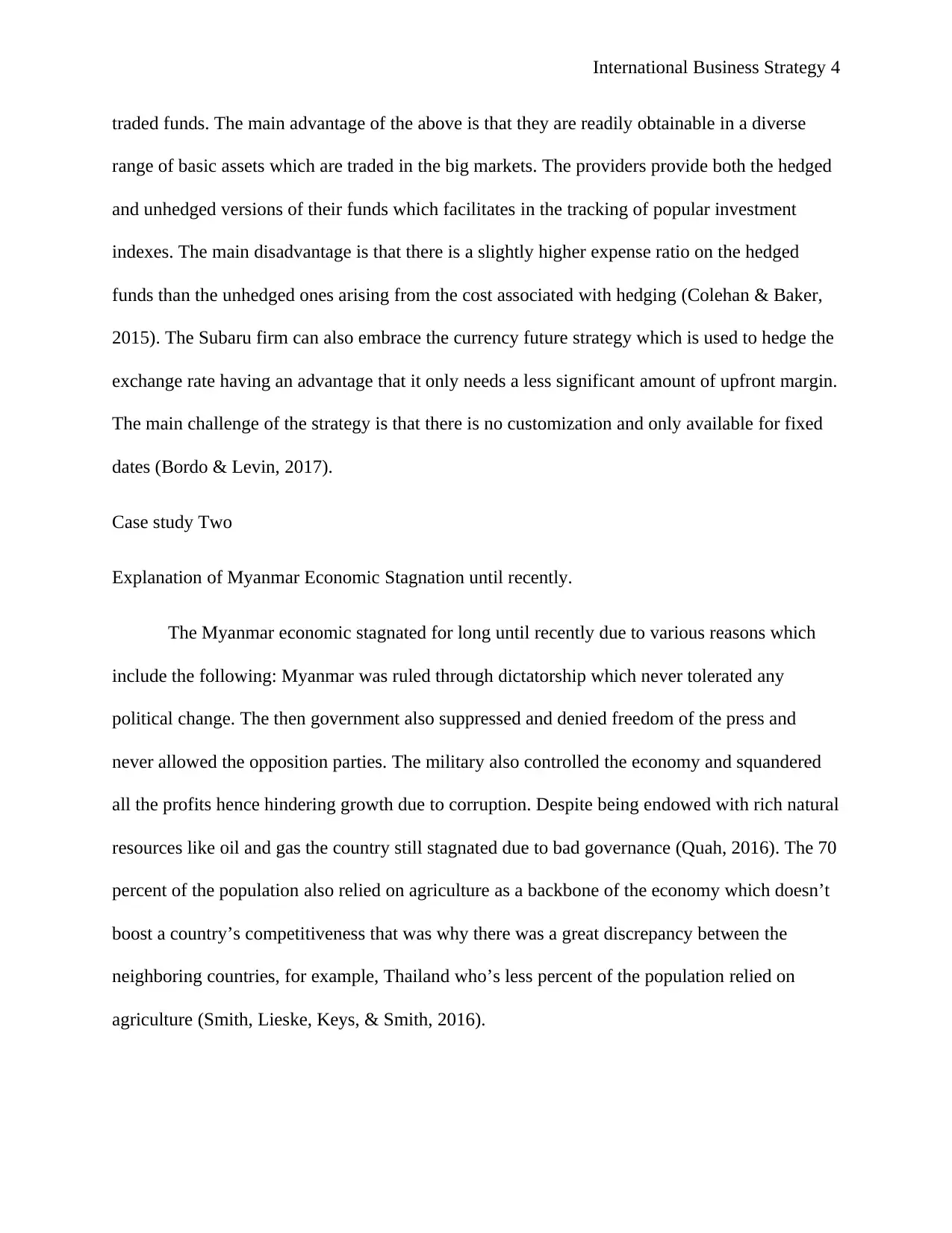
International Business Strategy 4
traded funds. The main advantage of the above is that they are readily obtainable in a diverse
range of basic assets which are traded in the big markets. The providers provide both the hedged
and unhedged versions of their funds which facilitates in the tracking of popular investment
indexes. The main disadvantage is that there is a slightly higher expense ratio on the hedged
funds than the unhedged ones arising from the cost associated with hedging (Colehan & Baker,
2015). The Subaru firm can also embrace the currency future strategy which is used to hedge the
exchange rate having an advantage that it only needs a less significant amount of upfront margin.
The main challenge of the strategy is that there is no customization and only available for fixed
dates (Bordo & Levin, 2017).
Case study Two
Explanation of Myanmar Economic Stagnation until recently.
The Myanmar economic stagnated for long until recently due to various reasons which
include the following: Myanmar was ruled through dictatorship which never tolerated any
political change. The then government also suppressed and denied freedom of the press and
never allowed the opposition parties. The military also controlled the economy and squandered
all the profits hence hindering growth due to corruption. Despite being endowed with rich natural
resources like oil and gas the country still stagnated due to bad governance (Quah, 2016). The 70
percent of the population also relied on agriculture as a backbone of the economy which doesn’t
boost a country’s competitiveness that was why there was a great discrepancy between the
neighboring countries, for example, Thailand who’s less percent of the population relied on
agriculture (Smith, Lieske, Keys, & Smith, 2016).
traded funds. The main advantage of the above is that they are readily obtainable in a diverse
range of basic assets which are traded in the big markets. The providers provide both the hedged
and unhedged versions of their funds which facilitates in the tracking of popular investment
indexes. The main disadvantage is that there is a slightly higher expense ratio on the hedged
funds than the unhedged ones arising from the cost associated with hedging (Colehan & Baker,
2015). The Subaru firm can also embrace the currency future strategy which is used to hedge the
exchange rate having an advantage that it only needs a less significant amount of upfront margin.
The main challenge of the strategy is that there is no customization and only available for fixed
dates (Bordo & Levin, 2017).
Case study Two
Explanation of Myanmar Economic Stagnation until recently.
The Myanmar economic stagnated for long until recently due to various reasons which
include the following: Myanmar was ruled through dictatorship which never tolerated any
political change. The then government also suppressed and denied freedom of the press and
never allowed the opposition parties. The military also controlled the economy and squandered
all the profits hence hindering growth due to corruption. Despite being endowed with rich natural
resources like oil and gas the country still stagnated due to bad governance (Quah, 2016). The 70
percent of the population also relied on agriculture as a backbone of the economy which doesn’t
boost a country’s competitiveness that was why there was a great discrepancy between the
neighboring countries, for example, Thailand who’s less percent of the population relied on
agriculture (Smith, Lieske, Keys, & Smith, 2016).
Paraphrase This Document
Need a fresh take? Get an instant paraphrase of this document with our AI Paraphraser
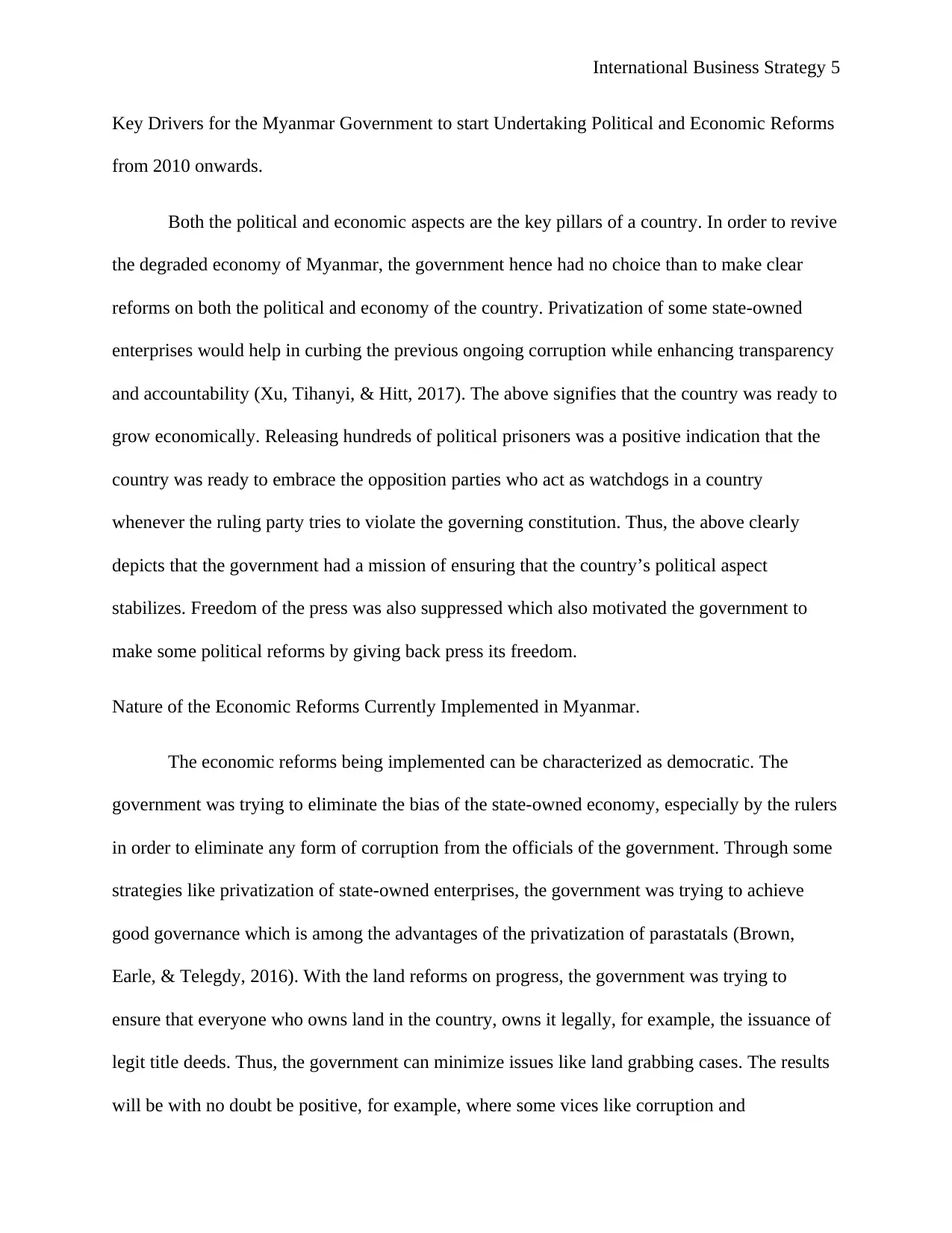
International Business Strategy 5
Key Drivers for the Myanmar Government to start Undertaking Political and Economic Reforms
from 2010 onwards.
Both the political and economic aspects are the key pillars of a country. In order to revive
the degraded economy of Myanmar, the government hence had no choice than to make clear
reforms on both the political and economy of the country. Privatization of some state-owned
enterprises would help in curbing the previous ongoing corruption while enhancing transparency
and accountability (Xu, Tihanyi, & Hitt, 2017). The above signifies that the country was ready to
grow economically. Releasing hundreds of political prisoners was a positive indication that the
country was ready to embrace the opposition parties who act as watchdogs in a country
whenever the ruling party tries to violate the governing constitution. Thus, the above clearly
depicts that the government had a mission of ensuring that the country’s political aspect
stabilizes. Freedom of the press was also suppressed which also motivated the government to
make some political reforms by giving back press its freedom.
Nature of the Economic Reforms Currently Implemented in Myanmar.
The economic reforms being implemented can be characterized as democratic. The
government was trying to eliminate the bias of the state-owned economy, especially by the rulers
in order to eliminate any form of corruption from the officials of the government. Through some
strategies like privatization of state-owned enterprises, the government was trying to achieve
good governance which is among the advantages of the privatization of parastatals (Brown,
Earle, & Telegdy, 2016). With the land reforms on progress, the government was trying to
ensure that everyone who owns land in the country, owns it legally, for example, the issuance of
legit title deeds. Thus, the government can minimize issues like land grabbing cases. The results
will be with no doubt be positive, for example, where some vices like corruption and
Key Drivers for the Myanmar Government to start Undertaking Political and Economic Reforms
from 2010 onwards.
Both the political and economic aspects are the key pillars of a country. In order to revive
the degraded economy of Myanmar, the government hence had no choice than to make clear
reforms on both the political and economy of the country. Privatization of some state-owned
enterprises would help in curbing the previous ongoing corruption while enhancing transparency
and accountability (Xu, Tihanyi, & Hitt, 2017). The above signifies that the country was ready to
grow economically. Releasing hundreds of political prisoners was a positive indication that the
country was ready to embrace the opposition parties who act as watchdogs in a country
whenever the ruling party tries to violate the governing constitution. Thus, the above clearly
depicts that the government had a mission of ensuring that the country’s political aspect
stabilizes. Freedom of the press was also suppressed which also motivated the government to
make some political reforms by giving back press its freedom.
Nature of the Economic Reforms Currently Implemented in Myanmar.
The economic reforms being implemented can be characterized as democratic. The
government was trying to eliminate the bias of the state-owned economy, especially by the rulers
in order to eliminate any form of corruption from the officials of the government. Through some
strategies like privatization of state-owned enterprises, the government was trying to achieve
good governance which is among the advantages of the privatization of parastatals (Brown,
Earle, & Telegdy, 2016). With the land reforms on progress, the government was trying to
ensure that everyone who owns land in the country, owns it legally, for example, the issuance of
legit title deeds. Thus, the government can minimize issues like land grabbing cases. The results
will be with no doubt be positive, for example, where some vices like corruption and
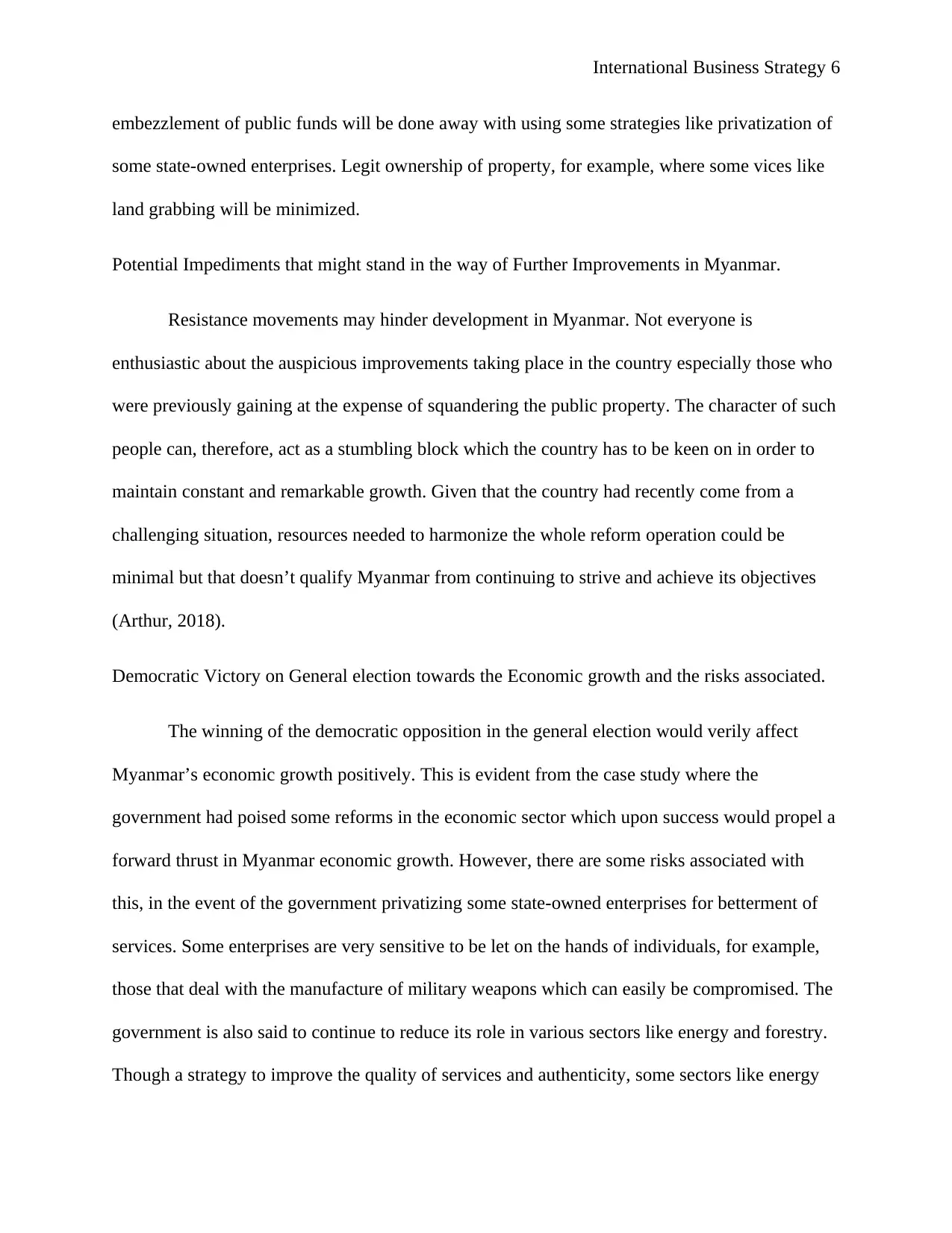
International Business Strategy 6
embezzlement of public funds will be done away with using some strategies like privatization of
some state-owned enterprises. Legit ownership of property, for example, where some vices like
land grabbing will be minimized.
Potential Impediments that might stand in the way of Further Improvements in Myanmar.
Resistance movements may hinder development in Myanmar. Not everyone is
enthusiastic about the auspicious improvements taking place in the country especially those who
were previously gaining at the expense of squandering the public property. The character of such
people can, therefore, act as a stumbling block which the country has to be keen on in order to
maintain constant and remarkable growth. Given that the country had recently come from a
challenging situation, resources needed to harmonize the whole reform operation could be
minimal but that doesn’t qualify Myanmar from continuing to strive and achieve its objectives
(Arthur, 2018).
Democratic Victory on General election towards the Economic growth and the risks associated.
The winning of the democratic opposition in the general election would verily affect
Myanmar’s economic growth positively. This is evident from the case study where the
government had poised some reforms in the economic sector which upon success would propel a
forward thrust in Myanmar economic growth. However, there are some risks associated with
this, in the event of the government privatizing some state-owned enterprises for betterment of
services. Some enterprises are very sensitive to be let on the hands of individuals, for example,
those that deal with the manufacture of military weapons which can easily be compromised. The
government is also said to continue to reduce its role in various sectors like energy and forestry.
Though a strategy to improve the quality of services and authenticity, some sectors like energy
embezzlement of public funds will be done away with using some strategies like privatization of
some state-owned enterprises. Legit ownership of property, for example, where some vices like
land grabbing will be minimized.
Potential Impediments that might stand in the way of Further Improvements in Myanmar.
Resistance movements may hinder development in Myanmar. Not everyone is
enthusiastic about the auspicious improvements taking place in the country especially those who
were previously gaining at the expense of squandering the public property. The character of such
people can, therefore, act as a stumbling block which the country has to be keen on in order to
maintain constant and remarkable growth. Given that the country had recently come from a
challenging situation, resources needed to harmonize the whole reform operation could be
minimal but that doesn’t qualify Myanmar from continuing to strive and achieve its objectives
(Arthur, 2018).
Democratic Victory on General election towards the Economic growth and the risks associated.
The winning of the democratic opposition in the general election would verily affect
Myanmar’s economic growth positively. This is evident from the case study where the
government had poised some reforms in the economic sector which upon success would propel a
forward thrust in Myanmar economic growth. However, there are some risks associated with
this, in the event of the government privatizing some state-owned enterprises for betterment of
services. Some enterprises are very sensitive to be let on the hands of individuals, for example,
those that deal with the manufacture of military weapons which can easily be compromised. The
government is also said to continue to reduce its role in various sectors like energy and forestry.
Though a strategy to improve the quality of services and authenticity, some sectors like energy
⊘ This is a preview!⊘
Do you want full access?
Subscribe today to unlock all pages.

Trusted by 1+ million students worldwide
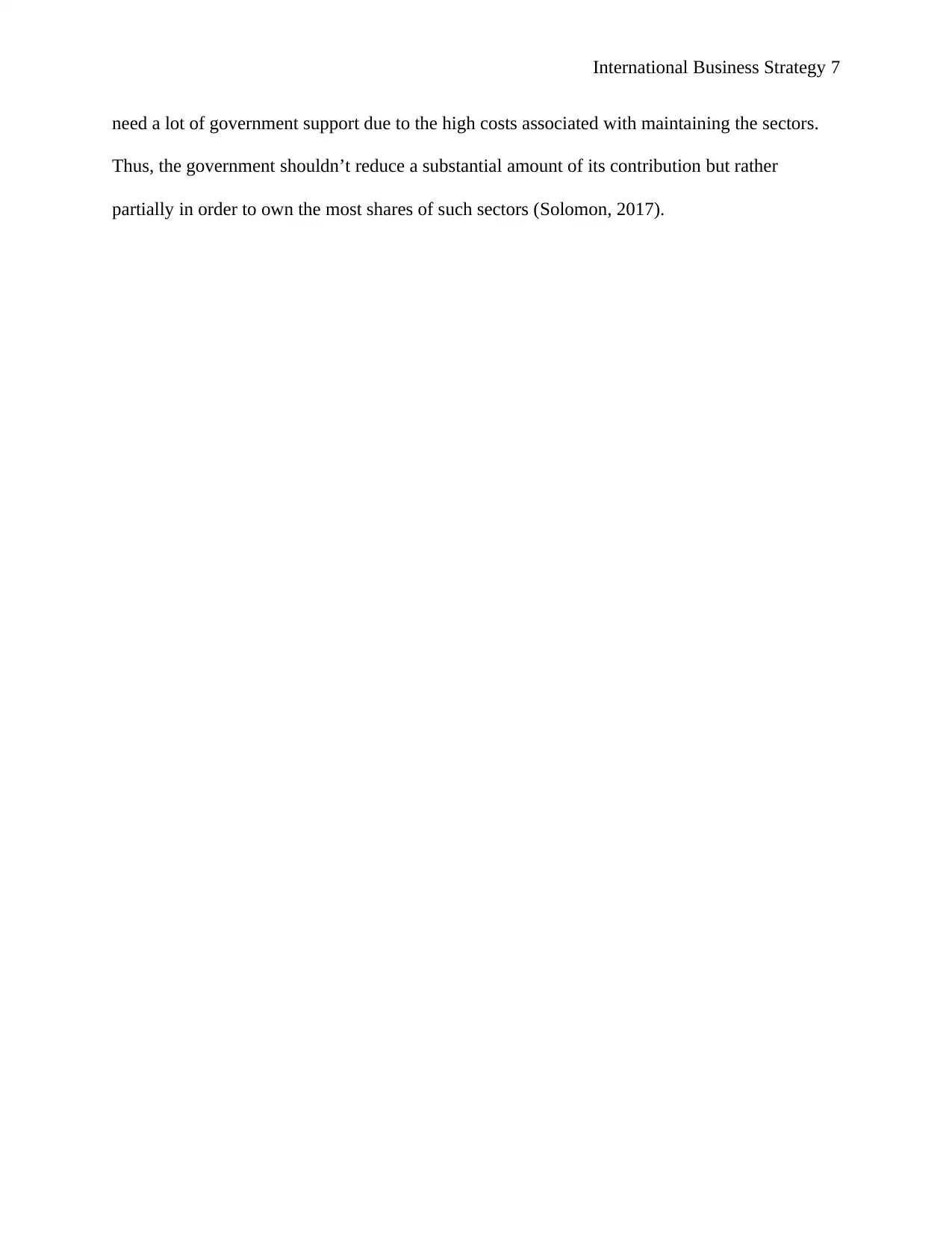
International Business Strategy 7
need a lot of government support due to the high costs associated with maintaining the sectors.
Thus, the government shouldn’t reduce a substantial amount of its contribution but rather
partially in order to own the most shares of such sectors (Solomon, 2017).
need a lot of government support due to the high costs associated with maintaining the sectors.
Thus, the government shouldn’t reduce a substantial amount of its contribution but rather
partially in order to own the most shares of such sectors (Solomon, 2017).
Paraphrase This Document
Need a fresh take? Get an instant paraphrase of this document with our AI Paraphraser
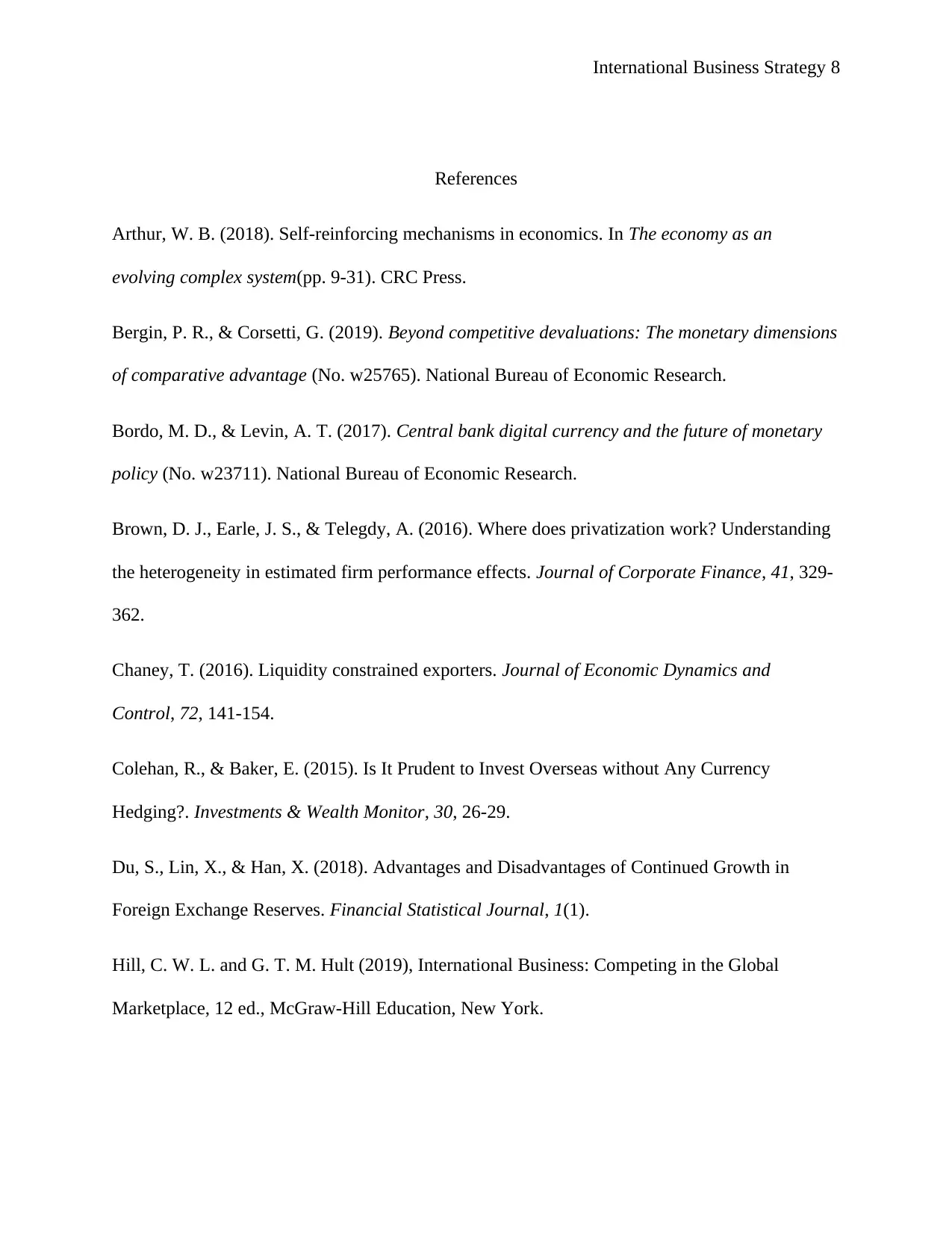
International Business Strategy 8
References
Arthur, W. B. (2018). Self-reinforcing mechanisms in economics. In The economy as an
evolving complex system(pp. 9-31). CRC Press.
Bergin, P. R., & Corsetti, G. (2019). Beyond competitive devaluations: The monetary dimensions
of comparative advantage (No. w25765). National Bureau of Economic Research.
Bordo, M. D., & Levin, A. T. (2017). Central bank digital currency and the future of monetary
policy (No. w23711). National Bureau of Economic Research.
Brown, D. J., Earle, J. S., & Telegdy, A. (2016). Where does privatization work? Understanding
the heterogeneity in estimated firm performance effects. Journal of Corporate Finance, 41, 329-
362.
Chaney, T. (2016). Liquidity constrained exporters. Journal of Economic Dynamics and
Control, 72, 141-154.
Colehan, R., & Baker, E. (2015). Is It Prudent to Invest Overseas without Any Currency
Hedging?. Investments & Wealth Monitor, 30, 26-29.
Du, S., Lin, X., & Han, X. (2018). Advantages and Disadvantages of Continued Growth in
Foreign Exchange Reserves. Financial Statistical Journal, 1(1).
Hill, C. W. L. and G. T. M. Hult (2019), International Business: Competing in the Global
Marketplace, 12 ed., McGraw-Hill Education, New York.
References
Arthur, W. B. (2018). Self-reinforcing mechanisms in economics. In The economy as an
evolving complex system(pp. 9-31). CRC Press.
Bergin, P. R., & Corsetti, G. (2019). Beyond competitive devaluations: The monetary dimensions
of comparative advantage (No. w25765). National Bureau of Economic Research.
Bordo, M. D., & Levin, A. T. (2017). Central bank digital currency and the future of monetary
policy (No. w23711). National Bureau of Economic Research.
Brown, D. J., Earle, J. S., & Telegdy, A. (2016). Where does privatization work? Understanding
the heterogeneity in estimated firm performance effects. Journal of Corporate Finance, 41, 329-
362.
Chaney, T. (2016). Liquidity constrained exporters. Journal of Economic Dynamics and
Control, 72, 141-154.
Colehan, R., & Baker, E. (2015). Is It Prudent to Invest Overseas without Any Currency
Hedging?. Investments & Wealth Monitor, 30, 26-29.
Du, S., Lin, X., & Han, X. (2018). Advantages and Disadvantages of Continued Growth in
Foreign Exchange Reserves. Financial Statistical Journal, 1(1).
Hill, C. W. L. and G. T. M. Hult (2019), International Business: Competing in the Global
Marketplace, 12 ed., McGraw-Hill Education, New York.
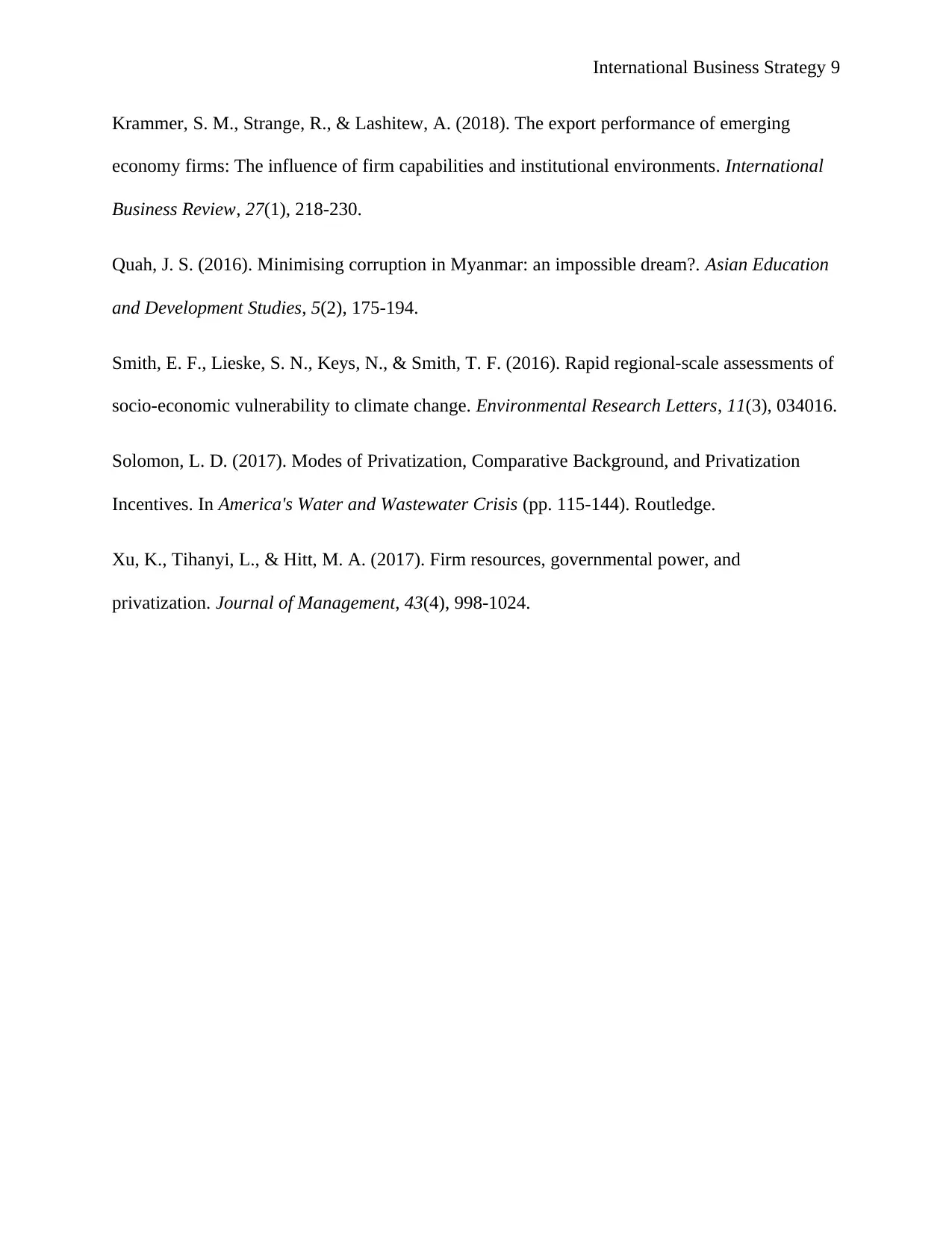
International Business Strategy 9
Krammer, S. M., Strange, R., & Lashitew, A. (2018). The export performance of emerging
economy firms: The influence of firm capabilities and institutional environments. International
Business Review, 27(1), 218-230.
Quah, J. S. (2016). Minimising corruption in Myanmar: an impossible dream?. Asian Education
and Development Studies, 5(2), 175-194.
Smith, E. F., Lieske, S. N., Keys, N., & Smith, T. F. (2016). Rapid regional-scale assessments of
socio-economic vulnerability to climate change. Environmental Research Letters, 11(3), 034016.
Solomon, L. D. (2017). Modes of Privatization, Comparative Background, and Privatization
Incentives. In America's Water and Wastewater Crisis (pp. 115-144). Routledge.
Xu, K., Tihanyi, L., & Hitt, M. A. (2017). Firm resources, governmental power, and
privatization. Journal of Management, 43(4), 998-1024.
Krammer, S. M., Strange, R., & Lashitew, A. (2018). The export performance of emerging
economy firms: The influence of firm capabilities and institutional environments. International
Business Review, 27(1), 218-230.
Quah, J. S. (2016). Minimising corruption in Myanmar: an impossible dream?. Asian Education
and Development Studies, 5(2), 175-194.
Smith, E. F., Lieske, S. N., Keys, N., & Smith, T. F. (2016). Rapid regional-scale assessments of
socio-economic vulnerability to climate change. Environmental Research Letters, 11(3), 034016.
Solomon, L. D. (2017). Modes of Privatization, Comparative Background, and Privatization
Incentives. In America's Water and Wastewater Crisis (pp. 115-144). Routledge.
Xu, K., Tihanyi, L., & Hitt, M. A. (2017). Firm resources, governmental power, and
privatization. Journal of Management, 43(4), 998-1024.
⊘ This is a preview!⊘
Do you want full access?
Subscribe today to unlock all pages.

Trusted by 1+ million students worldwide
1 out of 9
Your All-in-One AI-Powered Toolkit for Academic Success.
+13062052269
info@desklib.com
Available 24*7 on WhatsApp / Email
![[object Object]](/_next/static/media/star-bottom.7253800d.svg)
Unlock your academic potential
Copyright © 2020–2025 A2Z Services. All Rights Reserved. Developed and managed by ZUCOL.

